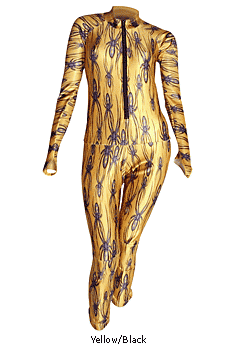
http://deneroff.com/Commentary/2003/1003.htm
Improvements to Ski Jumping
While the ski jumper can not change the elements around them during the
jump, they can improve what they wear, their aerodynamics, and what
they use on their skiis to decrease friction. In the image above
the racers are using suits that are made of a specific material,
usually a fine polyester knit, in order to decrease the drag when going
down the initial part of the ramp. Such suits sell for up
to $500+ and can vary from just plain colors to the outrageous one
below:

http://www.overstock.com/cgi-bin/d2.cgi?cid=52426&PAGE=PRODUCT&PROD_ID=15942&fp=F&kid=199966

http://www.snowlife.org.uk/jumping.asp

http://www.overstock.com/cgi-bin/d2.cgi?cid=52426&PAGE=PRODUCT&PROD_ID=15942&fp=F&kid=199966
One of the biggest improvements to the sport has to be the skiis they
use and the wax they put on them. In this day in age, ski
manufactures have created waxes that have a range of 10 degrees of what
the conditions are at the time of the competition. Hundreds
of waxes, all with different make-up, are used for humid and cold
conditions, cold and dry, humid and warmer, dry and around 30 degrees,
the combinations have proven endless! Believe it or not, but in
an 1998 Story in the Purdue News, two Students created a ski wax
out of Soybean and Canola oils (Mulvaney and Howard!)

http://www.snowlife.org.uk/jumping.asp
Two big names have come about through the evolution in ski jumping,
Rossignol and Atomic. The Atomic skiis can be seen above,
and both tend to have a basic wide ski that is almost 2 feet longer
than that of the jumper. The bindings to the ski, as you can see,
have the ability to move slightly to provide a larger airfoil with a
compromise to stability.
Index
The History and Overview of Ski Jumping
The Physics Behind Ski Jumps
Using Physics to Aid the Jumper
Improvements to Ski Jumping
Bibliography
The History and Overview of Ski Jumping
The Physics Behind Ski Jumps
Using Physics to Aid the Jumper
Improvements to Ski Jumping
Bibliography